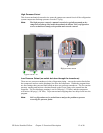
GP Series Portable Chillers Chapter 2: Functional Description 7 of 90
Chapter 2: Functional Description
2-1 Models Covered in This Manual
This manual provides operation, installation, and maintenance instructions for air-, water-and
remote air-cooled portable chillers. Model numbers are listed on the serial tag. Make sure you
know the model and serial number of your equipment before contacting the manufacturer for
parts or service.
Our portable chiller models are designated by approximate output in kW of cooling (20, 30,
40, 50, through 210) and the cooling method used: -A for air-cooled, -W for water-cooled,
and –R for remote-air cooled.
2-2 General Description
Our portable chillers are reliable, accurate, and easy to use process cooling units. They are
available in air-, water-, and remote air-cooled designs in a range of sizes from 20 kW
through 210 kW (5 through 60 tons of refrigeration). All are self-contained, fully portable and
shipped ready to use. (Remote air-cooled chillers require field installation by qualified
technicians.) In the standard configuration the chiller basically consists of a pump, tank,
compressor, condenser, evaporator, and a control platform. All of these components, plus the
other integral components to maintain the leaving fluid temperature, are described throughout
this Chapter as well as Chapters 3 and 4.
Standard range of operation is 20ºF to 80ºF (-7ºC to 27ºC) for applications using a
water/glycol mix and 45ºF to 80ºF (7º to 27ºC) for water only applications.
Typical Applications
This series of portable chillers can be used in any application that needs a constant source of
cool process water. Typical applications include, but are not limited to, the following:
Injection molding Blow molding
Extrusion Thermoforming
Machine tool Metal plating
Thermal spray After-coolers (air compressors, dryers, etc.)
Laser Printing (offset, gravure, digita)
System Limitations
These packaged chillers should be chosen using the following criteria:
Process heat load – Choose the size of the chiller so that rated capacity is no greater than
10% more than the process heat load.


















